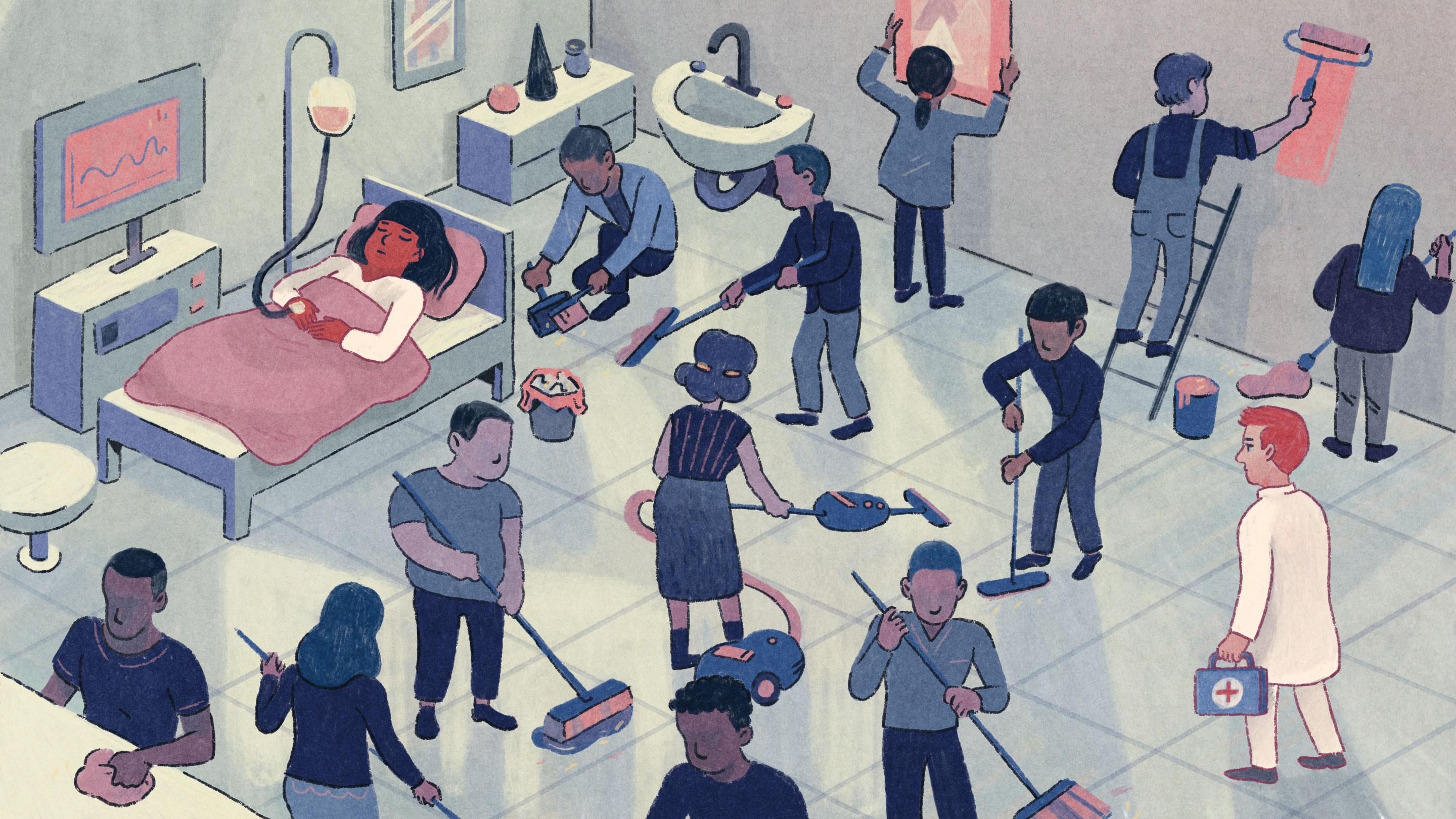Bacteria Sacrifice DNA Repair for Better RNA

In bacteria, the processes that help to clean up errors in RNA transcripts of genes can get in the way of the processes that repair DNA.
Boya Sun for Quanta Magazine
Introduction
Evolution is a game of trade-offs. Every trait an organism inherits may have benefits and drawbacks; what matters to natural selection is whether the trait is positive or negative on balance. But in a recent study, researchers described a balancing act that seems more counterintuitive than most: Bacterial cells prioritize transcription — the process of making RNA transcripts of genes as the first step in protein production — over repairing double-strand breaks in their DNA.
“We tend to think of DNA as the brains of the cell,” said Susan Rosenberg, a biologist at Baylor College of Medicine in Houston. “If we push that analogy and think about parts of the cell competing for resources the way the parts of the body do, the brain should be getting whatever it needs at the expense of everything else.”
So when her Baylor colleague Christophe Herman approached her with the hypothesis that transcription might be more important than DNA repair, Rosenberg was ready to bet the other way. “And I was sure I would win,” she said.
But she was proven wrong. Last month, she, Herman and their team published the results of their research in Nature: They found, using a series of experiments and intricate controls, that transcription can trump DNA repair in E. coli.
Rosenberg’s initial skepticism makes sense. DNA is the basis of heredity, after all, and a broken chromosome can be fatal. Errors in an RNA transcript, on the other hand, seem less grave. Such transcripts are temporary and short-lived, and the cell usually makes more than one copy. “When your house is on fire, you do not drop everything to make sure you took an accurate copy from one of your books in your home library,” said Andrei Kuzminov, a microbiologist at the University of Illinois who was not involved in the study. “You run for your life!”
But the story turns out to be much more complicated: A traditional DNA-centric perspective isn’t always best for explaining how complex processes like repair and transcription interact.
Transcription’s Rise to Power
Herman began to suspect that exaggerating the importance of DNA could be a mistake nearly a decade ago, when he found that errors made when copying DNA into RNA can lead to heritable changes in E. coli cells. (Those effects were epigenetic, meaning that the cells’ DNA was chemically modified while its base sequence remained the same.) Other research has also shown a correlation between transcription errors and diseases including cancer, multiple sclerosis and Alzheimer’s, although the link isn’t necessarily causal. And the final piece of the puzzle, according to Herman, dropped into place last year, when the J. Craig Venter Institute and Synthetic Genomics created a cell from scratch with the minimum genome an organism needs to survive. Herman noted that among the synthetic cell’s 473 genes, “very few coded for proteins involved in DNA repair.” But the major protein involved in maintaining transcription fidelity was there. “It was essential for life,” Herman said.
Scientists had started digging deeper into ways that transcription processes might incidentally assist with the repair of DNA. But the Baylor team’s new findings suggest that those processes can also sometimes be an obstacle.
Herman, Rosenberg and their colleagues removed the gene in E. coli that encodes the transcription fidelity factor GreA, a type of proofreading protein that ensures cells make the correct RNA transcripts. The team then induced double-strand DNA breaks using a drug that mimics radiation. They found that in the absence of GreA, the cells became much more resistant to the drug’s damaging effects. In fact, the bacteria’s ability to repair their DNA improved 100-fold. “They went from being mild-mannered E. coli to being the champions of radiation repair,” Rosenberg said.
“I think most folks would not have guessed that cells would be dispensing with any of the possible DNA repair activity they could have,” she added, “particularly not in favor of a good-quality transcript.” But that seems to be what’s happening: A single transcription-related protein is hobbling a repair process that would otherwise work 100 times better than we see in nature.
Roadblocks and Collisions
Usually, when a chromosome experiences a double-strand break, an enzyme starts to degrade the adjacent DNA as a prelude to repair. In E. coli and other bacteria, when this enzyme reaches a sequence of nucleotides called a Chi site, it stops chewing up DNA and starts the repair process.
Meanwhile, when a transcription error occurs, the complex of unfinished RNA and polymerizing enzymes stalls until GreA and other transcription factors enable the removal of the incorrect nucleotide.
Herman and Rosenberg proposed that without GreA, the transcription complex stays attached to the DNA. If the DNA-degrading enzyme then comes down the strand, it runs into the stalled complex and interprets that collision as a Chi site, switching over to DNA repair. “If you don’t stop [the enzyme] with that kind of signal, the DNA can get degraded up to something like a million bases,” Herman said. “If you don’t tell it to stop degrading and start [repairing], you’ll be in trouble. Here, it seems like the cell found a different way to do that.”
The scientists developed a method to visualize the repair process based on genomic sequencing, and with it found good evidence for their hypothesis: In the cells that lacked GreA, less DNA degradation surrounded the sites of DNA breaks. To Herman and Rosenberg, it implied that stalled transcription complexes may have been promoting more repair.
Backing the Proteome
According to Herman, this observation demonstrates that it is critical for a cell to generate the right proteins, because poorly made proteins can be more dangerous to the cell than a broken chromosome is. Messenger RNA transcripts are not made in the large quantities one might expect: Sometimes a cell’s production of a vital protein depends on only a handful of them — even as few as one. A single poor transcript could therefore have devastating consequences, not just by directly altering a cell’s enzymatic activity but through a domino effect that leaves other, unrelated proteins unable to function right.
Researchers have been doing the math wrong when thinking about this problem, Rosenberg said. During cell division in a rapidly growing population of E. coli, cells contain more than one copy of their single chromosome. If the DNA breaks in one copy, it may be fatal to one lineage of daughter cells, but the other lineages would be fine. If the dividing cell’s set of proteins (its proteome) is compromised by defective RNA transcripts, however, all the progeny may be unfit.
“The calculus here is that one bad transcript can produce a very large number of bad proteins,” Rosenberg said. “The final live-or-die moment in the cell’s life has more to do with the composition of the proteins in its cell than the loss of the chromosome.”
“It’s an exciting finding,” said Jean-François Gout, an evolutionary biologist at Arizona State University. “I think the story makes perfect sense.” When a conflict occurs between the complexes involved in processes like transcription and repair, which have access to DNA at the same time, “evolution is inevitably going to push you toward the best balance,” he added.
A Game of Trade-offs
Other experts interpret Herman and Rosenberg’s results differently. Nikolay Zenkin, a molecular biologist at Newcastle University in England, thinks evolution didn’t strike a balance between transcription and DNA repair. Instead, it found a way to ameliorate a different conflict — between transcription and DNA replication. Stalled transcription complexes don’t just lend DNA repair processes a helping hand; they can also end up causing double-strand breaks by interfering with the cellular machinery that replicates DNA. GreA thus promotes genomic integrity by preventing DNA breaks, even if it means compromising the repair of any breaks that do eventually happen. “Better to avoid the event than to be efficient in correcting it,” Zenkin said.
Moreover, added Robert Lloyd, a professor emeritus of genetics at the University of Nottingham in England, spontaneous double-strand breaks in E. coli are relatively rare. As a result, the Baylor team’s observations may not be all that surprising: The critical factor for the bacteria would be to express their genes accurately so that they can survive and flourish. “In a normal growing population,” Lloyd said, “the requirement of repairing DNA breaks would not be as great as the need to secure a competitive advantage against other species.” If the cells had evolved under extreme conditions that were more likely to break DNA, “they would have evolved different mechanisms to deal with that, and the efficiency of gene expression would no longer be the first concern.”
“This is not so much a conundrum as it is an inevitable advantage,” Lloyd said — a classic example of an evolutionary trade-off.
The discovery by Herman and Rosenberg paints a richer picture of how transcription can be involved with DNA metabolism, and the role transcription plays in ensuring the well-being of the cell, remarked Houra Merrikh, a microbiologist at the University of Washington. “Their study highlights how important it is that we get back to basic bacterial genetics,” Merrikh said. “There’s clearly still a lot we can learn, and a lot we don’t know about molecular mechanisms, that we can research using this kind of genetics.”
Herman and Rosenberg now want to see their mechanism confirmed by more direct biochemical experiments, and they hope to study the extent to which their results can be generalized beyond bacteria to more complex cells, including human ones. If something similar is happening in higher-level organisms, Rosenberg said, it may even impact cancer research. She speculated that in people prone to certain types of cancer, there could be a disadvantageous balance between the transcription and repair processes — and that slightly tuning down transcription fidelity could improve their health. “This finding is mind-blowing,” she added, “because it’s saying, no, you can tweak one little protein in the cell, and the cell can get so much better at DNA repair.” But she warned that the net effects could be more detrimental than beneficial, too, so any such potential treatment would need to be tested carefully.
Far-in-the-future medical advances aside, Herman hopes his findings will spark greater interest in research on transcription fidelity, which has always taken a back seat to the study of DNA repair. “Hopefully this will change the game,” he said. “And people will start to pay more attention.”



